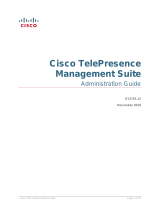
IP settings
(When not set by a provisioning system)
Your video conference system supports IP version 4 (IPv4),
IP version 6 (IPv6) and Dual, which is the default setting. In all
three cases, the IP parameters can be assigned automatically
by the network, or you can set everything manually. When set
to Dual, the network interface can operate on both IP versions,
and have both an IPv4 and an IPv6 address.
If you wish to set the parameters manually, contact your
network administrator to obtain the required parameters.
If you choose to set the IP settings manually while using the
Dual mode, you have to set both the IPv4 and the IPv6 settings.
Start from step 2 in the instructions.
If your system is provisioned automatically, these IP settings
may be overridden by the provisioning system.
If an IPv4 or IPv6 address is already assigned to the system,
you can find it on the System Information page. Go to the Setup
tab and choose Status and Network.
NOTE: It is not recommended to manually change the IP
address using the web interface, or a remotely paired Touch
controller.
To set or change the IPv4 settings
Go to the Setup tab and click Configuration.
1. Choose IP version
Click the Network settings in the left sidebar. Choose IPv4
from the IPStack drop down list.
2. Choose automatic or manual IP assignment
Scroll down the page to the IPv4 section and choose DHCP
from the Assignment drop down list, if you want automatic
IP assignment; or Static, if you wish to set the IP address
manually.
3. If you wish to set IP Assignment manually
In the IPv4 section, enter the Address, Gateway and
SubnetMask in the corresponding input fields.
Scroll up to the DNS section and enter the DNS server
address in the Server 1 Address input field.
* IP Assignment:
DHCPv6: All IPv6 addresses, including options like the DNS and NTP
server addresses, are obtained automatically from a DHCPv6 server.
Autoconf: The system and gateway IP addresses will be assigned
automatically. The options, e.g. NTP and DNS server addresses, must be
set/assigned according to the DHCP Options setting. **
Static: The system and gateway IP addresses must be configured
manually. The options, e.g. NTP and DNS server addresses, must be set/
assigned according to the DHCP Options setting. **
To set or change the IPv6 settings
Go to the Setup tab and click Configuration.
1. Choose IP version
Click the Network settings in the left sidebar. Choose IPv6
from the IPStack drop down list.
2. Choose automatic or manual IP assignment
Scroll down the page to the IPv6 section and choose
DHCPv6, Autoconf or Static from the Assignment drop
down list according to your network requirements.*
3. If IP Assignment is Static: Set the IP addresses
Enter the system IP address in the Address input field.
Optional: Enter the gateway address in the Gateway input
field.
4. If IP Assignment is Static or Autoconf: DHCPOptions
Choose On or Off from the DHCPOptions drop down list
according to your network requirements.**
5. If DHCPOptions is Off: Configure DNS and NTP
Scroll up to the DNS section, and enter the DNS server
address in the Server 1 Address input field.
Open the NetworkServices settings from the left sidebar,
and scroll down to the NTP section. Enter the NTP server
address in the Server 1 Address input field. Set Mode to
Auto.
** DHCP Options:
On: The IP parameters, like the DNS and NTP server addresses, will be
obtained automatically from a DHCPv6 server.
Off: The IP parameters, like the DNS and NTP server addresses, must be
set manually.
If you are changing a value setting,
you have to always click save to confirm the change.
Cisco TelePresence Video Systems
D15318.07 Video Systems Getting Started Guide CE9.2, NOVEMBER 2017. Copyright © 2017 Cisco Systems, Inc. All rights reserved. 15
Getting Started Guide






















